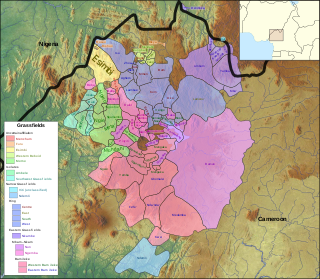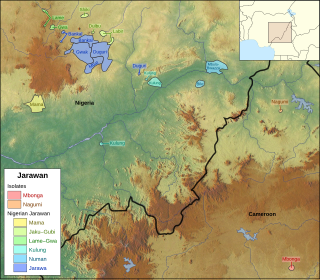Related Research Articles
Abanyom, or Bakor, is a language of the Ekoid subfamily of Niger–Congo. It is spoken by the Abanyom people in the Cross River State region of Nigeria. A member of the Southern Bantoid group, Abanyom is fairly closely related to the Bantu languages. It is tonal and has a typical Niger–Congo noun class system.
Bikya is a potentially extinct Southern Bantoid language spoken in Cameroon. It is one of the three, or four, Furu languages. In 1986 four surviving speakers were identified, although only one spoke the language fluently.

There are over 525 native languages spoken in Nigeria. The official language and most widely spoken lingua franca is English, which was the language of Colonial Nigeria. Nigerian Pidgin – an English-based creole – is spoken by 30 million people in Nigeria.

The Ekoid languages are a dialect cluster of Southern Bantoid languages spoken principally in southeastern Nigeria and in adjacent regions of Cameroon. They have long been associated with the Bantu languages, without their status being precisely defined. Crabb (1969) remains the major monograph on these languages, although regrettably, Part II, which was to contain grammatical analyses, was never published. Crabb also reviews the literature on Ekoid up to the date of publication.

The Grassfields languages are a branch of the Southern Bantoid languages spoken in the Western High Plateau of Cameroon and some parts of Taraba state, Nigeria. Better known Grassfields languages include the Eastern Grassfields languages, Bamun, Yamba, Bali, and Bafut and the Ring languages, Kom, Nso, and Oku. Almost all of these languages are closely related, sharing approximately half of their vocabulary.

Jarawan is a group of languages spoken mostly in Bauchi State, Nigeria, with some also scattered in Plateau State, Taraba State, and Adamawa State in the same country. Two related languages formerly spoken in Cameroon are now extinct but are believed to have belonged to the group. This connection between Nigerian and Cameroonian Jarawan is attributed to Thomas (1925). Whether Jarawan languages are best classified alongside other Bantu languages or among non-Bantu Bantoid languages is a matter of ongoing debate. A number of descriptions and classifications in the early 20th century suggest that they be may historically related to Bantu languages but not necessarily Bantu themselves. Other perspectives based on lexicostatistic modeling and other phylogenetic techniques for language comparison argue instead that Jarawan languages are properly classified alongside Zone A Bantu languages (A31-A40-A60). For classifications based on these more recent studies, see for example Blench (2006), Piron (1997), and Grollemund (2012).
Jarawa is the most populous of the Bantu languages of eastern Nigeria. It is a dialect cluster consisting of many varieties.
Shiki, or Gubi, is one of the Bantu languages of Nigeria, spoken in Bauchi State.
Toro, also known as Turkwam, is a Plateau language of Nigeria. It has lost the nominal affix system characteristic of the Niger–Congo family.
The Jagham language, Ejagham, also known as Ekoi, is an Ekoid language of Nigeria and Cameroon spoken by the Ekoi people. The E- in Ejagham represents the class prefix for "language", analogous to the Bantu ki- in KiSwahili
Mbula-Bwazza is one of the Bantu languages spoken in Nigeria. It is a dialect cluster; Blench (2011) divides it into several languages, as follows:
Naki, or Munkaf, is an Eastern Beboid language of Cameroon and Nigeria. There is no name for the language; it is known by the villages it is spoken in, including Naki and Mekaf (Munkaf) in Cameroon and Bukwen and Mashi in Nigeria, the latter listed as separate languages by Ethnologue, though they are not distinct.
Kulung is a Bantu language spoken in Nigeria.
Gaa, or Tiba, is a poorly documented language of Nigeria. It is apparently one of the Dakoid languages.
Dong, or Donga, is a poorly documented language in Nigeria. Though clearly Niger–Congo, it is difficult to classify; British linguist Roger Blench proposes that it is one of the Dakoid languages, the closest to Gaa.
Mfumte (Nfumte) is a Grassfields Bantu language of Cameroon. It is not clear if the four varieties spoken by ethnic Mfumte—Ndaktup, Kwaja, Fum and Mfumte proper—are mutually intelligible or distinct languages; ability to communicate may be either due to inherent intelligibility or to bilingualism, while Fum and Mfumte may simply be the Nigerian and Cameroonian names for the same language.
Lame is a Bantu dialect cluster spoken Nigeria. The Rufu *Ruhu) and Mbaru dialects are extinct as of 1987. Blench (2019) also lists Gura as a dialect.
Dulbu is one of the Bantu languages of Nigeria. Speakers are shifting to Hausa.
Labir, or Jaku, is one of the Bantu languages of Nigeria, spoken in Bauchi State.
Kulung (Wurkum) is a minor West Chadic language of Karim Lamido LGA, Taraba State, Nigeria that was recently discovered by Roger Blench. The language is not reported in Ethnologue or Glottolog. Blench (2019) gives a rough estimate of about 2,000 speakers.
References
- ↑ Bile at Ethnologue (18th ed., 2015) (subscription required)
- ↑ Blench, Roger (2019). An Atlas of Nigerian Languages (4th ed.). Cambridge: Kay Williamson Educational Foundation.